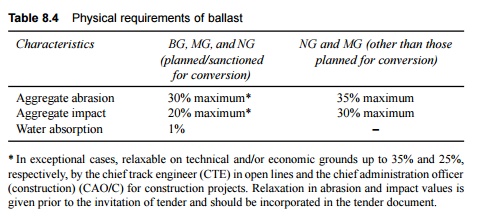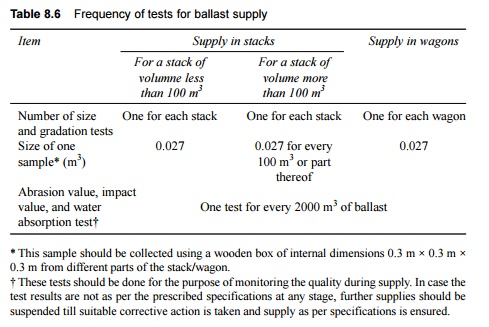Chapter: Civil : Railway Airport Harbour Engineering : Railway Engineering : Ballast
Specifications for Track Ballast
Specifications for Track Ballast
The following specifications of ballast, which have recently
been revised (June 2004), are followed on Indian Railways. These specifications
are applicable for the stone ballast to be used for all types of sleepers on
normal tracks, turnouts, tunnels, and deck slabs on all routes.
1 General Qualities
The ballast material should possess the general qualities
described below.
Basic quality The
ballast should be hard, durable, as far as possible angular along edges/corners,
and free from weathered portions of parent rock, organic impurities, and
inorganic residues.
Particle shape Ballasts
should be cubical in shape as far as possible. Individual pieces
should not be flaky and should have flat faces generally with not more than two
rounded/sub-rounded faces.
Mode of manufacture Ballasts
for all BG main lines and running lines, except on E routes, but
including E special routes, should be machine crushed. For other BG lines and
MG/NG routes planned or sanctioned for conversion, the ballast should
preferably be machine crushed. Hand broken ballast can be used in exceptional
cases with the prior approval of the chief track engineer or the CAO (chief
administrative officer). Such approval should be obtained prior to the
invitation of tenders. Hand broken ballasts can be used without any formal
approval on MG and NG routes not planned or sanctioned for conversion.
2 Physical Properties
All ballast samples should
possess the physical properties given in Table 8.4 when tested in accordance
with IS:2386 (IV)-1963.
Table 8.4 Physical requirements of
ballast

* In exceptional cases, relaxable
on technical and/or economic grounds up to 35% and 25%, respectively, by the
chief track engineer (CTE) in open lines and the chief administration officer
(construction) (CAO/C) for construction projects. Relaxation in abrasion and
impact values is given prior to the invitation of tender and should be
incorporated in the tender document.
3 Size and Gradation
The ballast should satisfy the size and gradation requirements
given in Table 8.5.
Table 8.5 Ballast gradation

4 Oversized Ballast
(a) Retention
on 65-mm square mesh sieve A maximum of 5% ballast retained on a
65-mm sieve is allowed without deduction in payment. In case the ballast
retained on a 65-mm sieve exceeds 5% but is less than 10%, payment at a 5%
reduction of 5% in the contracted rate is made for the full stack. Stacks
retaining more than 10% of ballast on a 65-mm sieve are rejected.
(b) Retention
on 40-mm square mesh sieve In case the ballast retained on a 40-mm
square mesh sieve (machine crushed only) exceeds the 60% limit prescribed
above, payment at the following reduced rates is made for the full stack in
addition to the reduction as worked out above.
(i) 5%
reduction in contracted rates if the retention on a 40-mm square mesh sieve is
between 60% (excluding) and 65% (including).
(ii) 10%
reduction in contracted rates if retention on a 40-mm square mesh sieve is
between 65% (excluding) and 70% (including).
(iii) In case
the retention on a 40-mm square mesh sieve exceeds 70%, the stack is rejected.
(iv) In the
case of hand broken ballast supply, 40-mm-sieve analysis may not be carried
out. The executive may, however, ensure that the ballast is well graded between
65 mm and 20 mm.
5 Undersized Ballast
The ballast is treated as undersized and rejected if
(a) retention
on a 40-mm sieve is less than 40% and
(b) retention
on a 20-mm sieve is less than 98% (for machine crushed ballast) or 95% (for
hand broken ballast).
6 Shrinkage Allowance
Payment is made for the gross
measurements either in stacks or in wagons without any deduction for
shrinkage/voids. However, when ballast is supplied in wagons, up to 8%
shrinkage is permitted at the destination by the consignee verifying the booked
quantities.
7 Sampling and Testing
The following procedure is specified for the sampling and
testing of the ballast.
(a) A minimum
of three samples of ballast should be taken for sieve analysis for measurement
done on any particular date, even if the number of stacks to be measured is
less than three.
(b) The tests
for abrasion value, impact value, and water absorption should be done in
approved laboratories or in the Railways' own laboratories (A list of these
laboratories should be given in the tender document).
(c) In order
to ensure the supply of a uniform quality of ballast, the specifications given
in Table 8.6 should be followed with respect to sampling, testing, and
acceptance of the ballast. The tests given in this table may be carried out
more frequently if warranted at the discretion of the Railways.
(d) On supply
of the first 100 m3, tests for size gradation, abrasion value,
impact value, and water absorption (if prescribed) should be carried out by the
Railways. Further supply should be accepted only after the first batch
satisfies these tests. The Railways reserves the right to terminate the
contract as per the general conditions of contract (GCC) at this stage itself
in case the ballast supply fails to meet any of these specifications.
Table 8.6 Frequency of tests for
ballast supply

* This sample should be collected using a wooden box of
internal dimensions 0.3 m × 0.3 m × 0.3 m from different parts of the
stack/wagon.
† These tests should be done for
the purpose of monitoring the quality during supply. In case the test results
are not as per the prescribed specifications at any stage, further supplies should
be suspended till suitable corrective action is taken and supply as per
specifications is ensured.
Related Topics